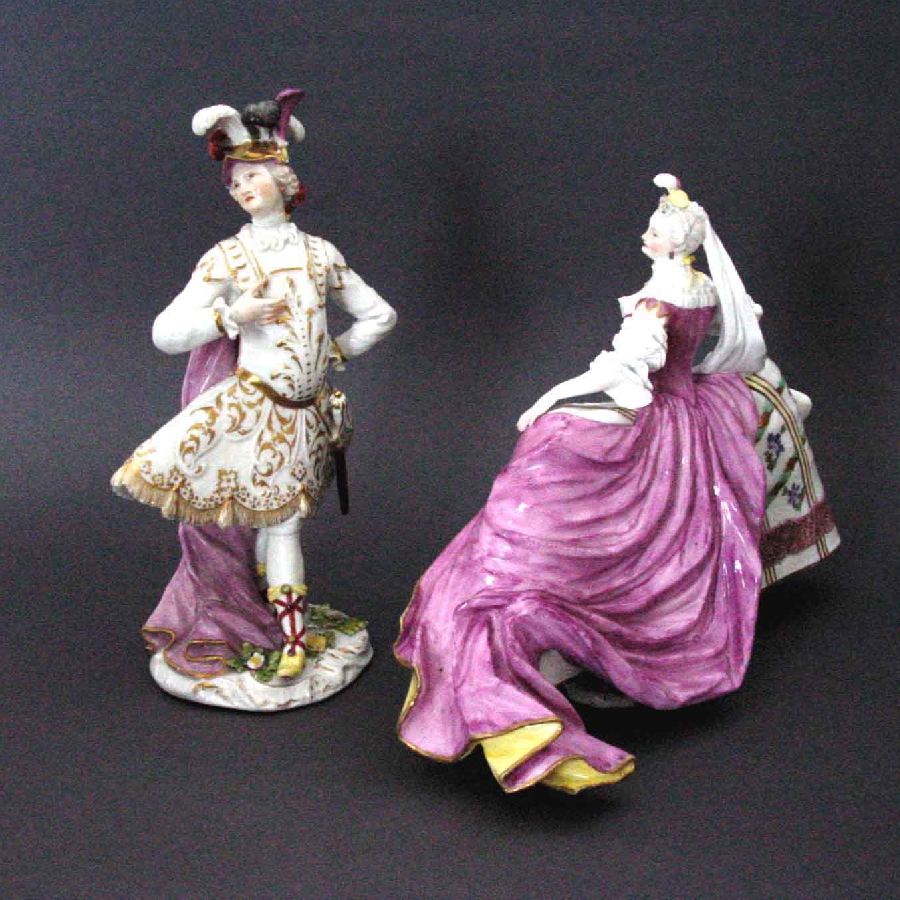Important Pair of Meissen Theatrical Figures of Dancers
said to represent Mme Pompadour and the Vicomte de Rohan
Modelled by Johann J.Kaendler and Peter Reinicke For The Prinz Heinrich von Preussen
Ca. 1760
Acquired by an Italian private collector

Marks
None
Measurements
Rohan: 23.5 H; Pompadour: 21 cm.
Condition
Rohan: Two plumes and top and end of sword replaced, fire cracks cleaned, permanently secured and not sprayed; Pompadour: Right hand and plumes replaced, left arm re-stuck, minute chips to edge of dress restored, fire cracks cleaned, permanently secured and not sprayed.
Note
Both figures have undergone tests with the Spectral analysis in the Universität Erlangen in Dezember 2003. This scientific test revealed a date of manufacture before 1765.
The dramatically modelled figures are thought to be representing Mme Pompadour as Galathea and the Prince de Rohan or Louis XV as Acis. Mme Pompadour, the King and many members of the court at Versailles regularly directed and played theatrical pieces. In particular Mme Pompadour has been known for her theatrical talent and her clear voice which had been trained by Jéliotte of the Comédie Francaise. She had also undergone training to recite. A performance of “Acis and Galathea” is recorded to have taken place at Versailles in 1749. The present sculptures seem to be based on a lost engraving by Charles Nicolas Cochin the elder. This engraving is known to us today only through a 19th century drawing by an anonymous artist, published by M.v.Boehn, Die Mode, Munich 1919, p.65.
Recent research has proven that these Meissen porcelain figures were made on commission for Prinz Heinrich von Preussen in 1760. The Meissen archives list these figures as “Römer” and “Römerin”, the official name of opera artists at that time, see the exhibition catalogue, Prinz Heinrich von Preussen Ein Europäer In Rheinsberg, Berlin 2002, pp.474-475, VII.52a and b. Wittwer argues here that the 19th century drawing is too small in order to allow a definite identification to Mme Pompadour and the Vicomte de Rohan.
I believe that the artist who copied the original engraving by Cochin must have copied the title as well. It seems inconceivable that the copyist would invent a new title. It is a fact that the play „Acis and Galathea“was first performed in Versaille in 1749 by Mme Pompadour, the Prince de Rohan.
The Marquise de Pompadour had two small theatres built in Versailles for amateur performances. A passion she shared with Louis XV. It is said that Louis XV himself performed in the play as well. This information seems to have led K.Berling to identify the male dancer as Louis XV (erroneously published in his “Festschrift” of 1910 as Louis IVX).
Literature
Only one other example of a complete pair is known in the Wadsworth Athenaeum, Hertford, Connecticut (not published).
The Kocher collection in the Historisches Museum in Bern owns a pair which is later decorated.
Y.Hackenbroch mentions in her Untermyer Collection Catalogue another pair in a private collection in Geneva. This example seems to be unpublished and could be this present pair.
The pair, formerly in the Berlin Schlossmuseum in Berlin now seems to be lost, see K. Berling, Meissen, Toronto and London 1972, colour ill. Table 6, no. 5 where the male figure is titled erroneously as Louis XIV.
The Pauls Eisenbeiss collection in the Historisches Museum in Basel (see I. Menzhausen, In Porzellan verzaubert, Basel 1993, pp.120-123 and E. Pauls-Eisenbeiss, German porcelain of the 18th Century, London 1972, vol.I, p.228) and the Metropolitan Museum in New York only own the figure of the female dancer only (Y.Hackenbroch, The Untermyer Collection Catalogue, London 1956, pp.31-32, No.30, ill. 24 and 25) . The two figures of the female dancer in the Pauls-Eisenbeiss collection were formerly in the Margarete Oppenheim collection and on loan to the Schlossmuseum in Berlin until 1933. The example with the purple bodice still shows the loan no. ‚LG 208’ in iron red on the base.
